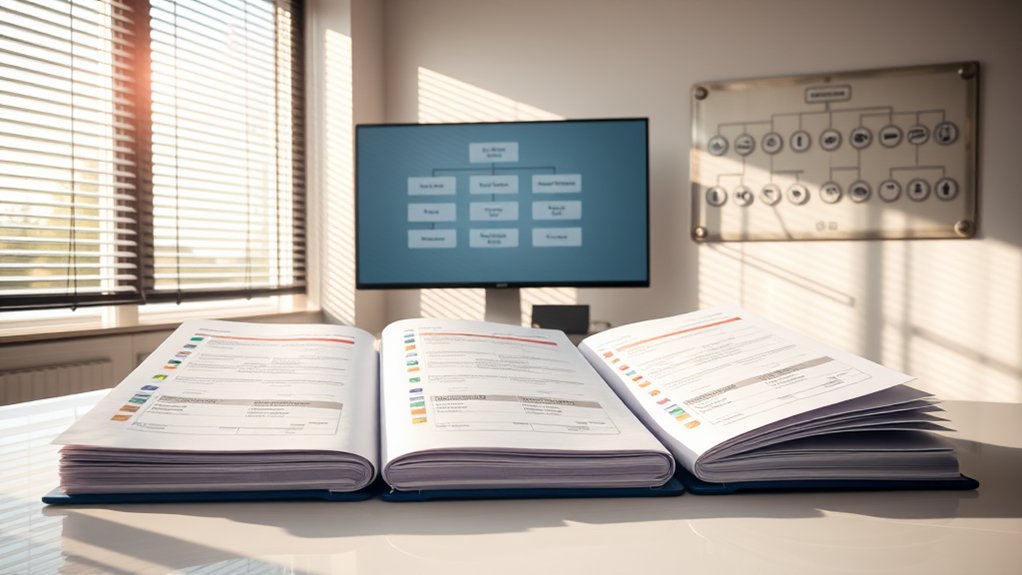To handle multi-department bookkeeping effectively, I recommend implementing five essential systems. Start with a hierarchical chart of accounts that assigns unique identifiers to each department. Then establish systematic cost allocation methods, deploy real-time budget tracking tools, standardize your reporting protocols, and streamline inter-departmental transactions. Each of these components works together to create a robust financial management framework that’ll transform your organizational efficiency. Let’s explore each system in detail.
Setting Up a Multi-Departmental Chart of Accounts

Every multi-departmental business needs a well-structured chart of accounts that clearly separates financial activities by department while maintaining overall organizational cohesion. I recommend creating a hierarchical numbering system where each department receives its own unique identifier. For example, assign 1000-1999 for administration, 2000-2999 for operations, and 3000-3999 for sales.
Within each range, I’ll help you establish subcategories for revenues, expenses, assets, and liabilities. This systematic approach enables precise tracking, simplifies consolidation, and empowers you to generate both departmental and company-wide financial reports with maximum efficiency and control.
Implementing Cost Allocation Systems
Three key components form the foundation of an effective cost allocation system: identification of cost pools, selection of allocation bases, and implementation of distribution methods. I’ll help you master these elements to optimize your multi-departmental accounting structure.
- Pool your overhead costs into logical groupings like facilities, IT infrastructure, and administrative support
- Select appropriate allocation bases that reflect actual resource consumption (square footage, headcount, or direct labor hours)
- Apply systematic distribution methods using accounting software to automatically allocate shared costs across departments
This framework enables you to accurately track departmental profitability, make data-driven decisions, and maintain precise control over your organization’s financial performance.
Managing Departmental Budget Tracking

With your cost allocation system in place, effective departmental budget tracking becomes your next key focus. I recommend implementing real-time monitoring dashboards for each department’s spending against their allocated budgets. You’ll need to establish variance thresholds that trigger automatic alerts when departments approach or exceed their limits.
I’ve found that linking your accounting software to department-specific cost centers enables granular tracking of expenses and revenues. Create customized reports that highlight key performance indicators, track budget utilization rates, and flag anomalies. This empowers you to make swift adjustments, hold department heads accountable, and maintain precise financial control across your organization.
Establishing Clear Financial Reporting Protocols
Financial reporting protocols serve as the backbone of multi-departmental accounting systems, requiring standardized procedures that align with your organization’s structure. I’ll help you implement robust reporting frameworks that guarantee data integrity and strategic decision-making across all departments.
- Establish mandatory reporting templates that capture key performance indicators, variance analyses, and departmental cost allocations
- Define clear submission deadlines and approval hierarchies to maintain control over financial data flow
- Implement automated validation checks to verify data accuracy and inter-departmental reconciliation
Streamlining Inter-Departmental Transactions

Managing transactions between departments requires a well-designed system that eliminates bottlenecks and reduces processing delays. I’ve found that implementing standardized transfer pricing and automated approval workflows dramatically improves efficiency.
| Action Item | Implementation Strategy |
|---|---|
| Cost Centers | Assign unique identifiers |
| Transfer Codes | Create standardized pricing |
| Approvals | Set automated thresholds |
| Documentation | Mandate digital receipts |
| Reconciliation | Schedule monthly reviews |
I recommend centralizing all inter-departmental transactions through your enterprise resource planning (ERP) system. This guarantees proper allocation of costs, maintains audit trails, and provides real-time visibility into departmental performance. You’ll need to establish clear transfer pricing policies to accurately reflect resource consumption between units.









